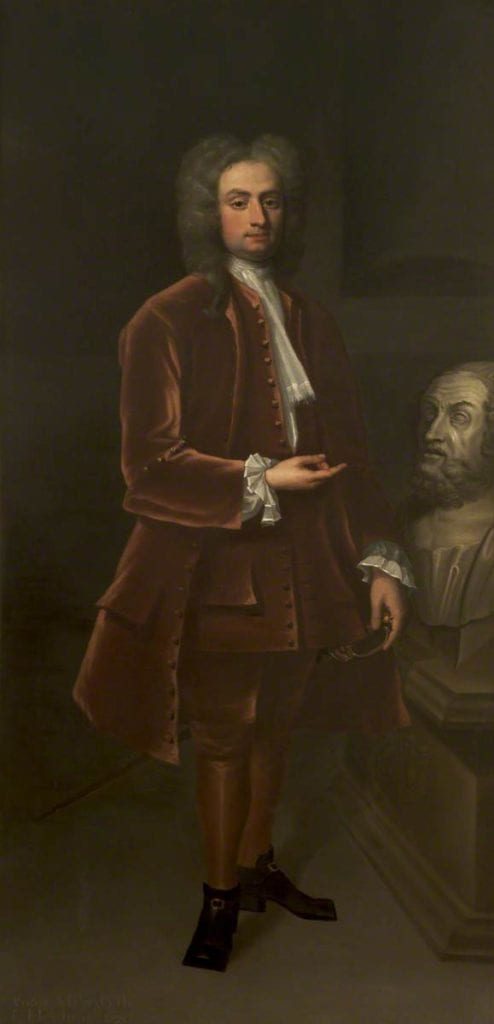

In 1752 Mary Meredith married Laurence Shirley, 4th Earl Ferrers. Her parents must have been well pleased that their youngest daughter had made such a prestigious marriage.
The Ferrers home was Staunton Harold Hall in Leicestershire, an estate Laurence had inherited with others in Derbyshire and Northamptonshire from his uncle, the 3rd Earl Ferrers. But that was not all he inherited. Contemporary accounts record that there was ‘insanity’ in the Ferrers family.
Today there would be a more scientific diagnosis for Laurence’s violent behaviour, which was probably exacerbated by his excessive drinking and debauched lifestyle. But by 1758 Mary could take no more and obtained a separation from her husband on the grounds of his cruelty. The upshot of this plunged Laurence into frequent paroxysms of rage.
The Ferrers estate was required to pay Mary rents due to her and an old retainer, a man by the name of Johnson, was appointed to collect the said rents. On January 18, 1760 Laurence sent for Johnson. Following a drunken tirade Laurence turned on Johnson and shot him. The family physician Dr. Thomas Kirkland, was sent for and attempted to treat the fatally wounded man before removing him to his own home where he died the following day.
A high-profile murder trial took place at Westminster Hall where Laurence pleaded insanity. However, he was found guilty of the murder of his steward and sentenced to death. On May 5, 1760, dressed in the lavish suit of clothes he had worn on his wedding day, Laurence was taken from the Tower of London to the place of execution at Tyburn. He bears the dubious distinction of being the last peer to be hanged.
But what became of Mary?
Perhaps in the hope of a happier life, Mary married for a second time. Her husband, Lord Frederick Campbell, was the third son of John, 4th Duke of Argyll and the couple married at the church of St. Martin in the Fields on March 28, 1769.
The Campbell family home was Coombe Bank, an elegant pile situated in the Kentish countryside at Sundridge. The Palladian villa designed by Roger Morris (who incidentally is believed to be responsible for the remodelling of Lydiard House) was built during the second quarter of the 18th century so a relative new build when Mary arrived.
Mary’s second marriage was a long one and produced two daughters, but it too ended in tragedy.
An alarming fire broke out, on Saturday morning, about three o’clock, at Croombank, in Kent, the seat of Lord Frederick Campbell, uncle to his Grace the Duke of Argyll. It commenced in Lady F. Campbell’s bedchamber, who we regret to state, fell a sacrifice to the flames, which raged with such violence as to preclude all possibility of rendering her Ladyship any assistance. This venerable lady was in her 70th year. One wing of the mansion is entirely consumed. As soon as the express arrived in town, on Saturday, the Duke of Argyll set off for Croombank, and had not returned last night.
Monday 27 July 1807
The sad story of Mary’s death continues to dominate the history of Coombe Bank with the inevitable gory embellishments and ghostly citings. Today, the Radnor House School occupies the Grade I listed building on the outskirts of Sevenoaks.
So, what is the connection between Mary Meredith and the St. John family, as regular readers will know there must be one?
Mary Meredith was born in 1730, the youngest of nine children. Her father was Amos Meredith, about whom little can be discovered other than a rather splendid portrait painted c1720. The painting, which describes Amos as ‘a Cheshire gentleman in plum coat’, hangs in Tatton Park, Cheshire.
Our St. John interest (the clue is in her Christian name) comes via his wife Johanna Cholmondeley. Johanna was born on October 23, 1692 and baptised at St. Mary’s, Battersea (second clue) five days later. Her father was Thomas Cholmondeley of Vale Royal, Cheshire who served as Sheriff of Cheshire in 1660 and MP in 1669. Thomas married twice, firstly to Jane Tollemache. His second wife and Johanna’s mother, was Anne St. John, daughter of Sir Walter St. John and his wife Johanna. Ta Dah!
So, (just in case you’ve got a bit lost) Mary Meredith was the great-granddaughter of Lady Johanna, gardener and herbalist healer who lived at Lydiard Park and in Battersea. Johanna died at Battersea on January 15, 1704 and was buried there in the St. John family vault in St. Mary’s. In her will she left her ‘great recit book’ believed to be her book of medicinal recipes now deposited at the Wellcome Library, to her eldest daughter Anne, Mary’s grandmother.

Lady Mary Campbell by Thomas Gainsborough

A pen and ink drawing of Lady Campbell by Henry Bone, after an unknown artist dated 1807, the year in which Mary died.

Amos Meredith painted in the style of the British School c1720.

Coombe Bank c1787.